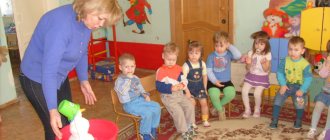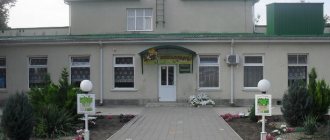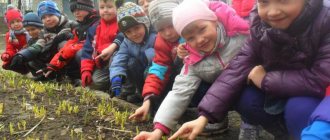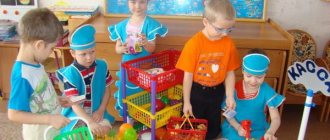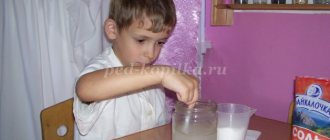Mini-laboratory “Get to know” - experimental research activities of preschoolers
- Relevance of the selected topic 2
- The merits of experimental research activities 3
- Current state of issue 4
- Didactic meaning of design and research activities 5
II Systematic performance of work.
- The pedagogical idea of creating a mini-laboratory "Find out
»,
characteristics of modules 6
- Principles of building a mini-laboratory 7
- Objectives of experimentation in early preschool age 9
- Tasks of experimentation in older preschool age. 10
- Safety rules when conducting experimental research activities 11
Application
- List of equipment and materials for the laboratory. 13
- The result of the pedagogical idea in using the mini-laboratory “Know-ka” 14
- Literature 15
- Experimental research experiments, experiments for children of primary preschool age. 16
- Experimental research experiments, experiments for children of senior preschool age. 21
- Algorithm for conducting experiments for preschool children 44
“Be able to open up to the child in the world around him
one thing, but open it so that a piece of life
played in front of the children with all the colors of the rainbow.
Always leave something unsaid so that the child
wanted to return once again to what he learned
(V. A. Sukhomlinsky)
How to bring children to a simple understanding of the elementary laws of the world around them, encourage them to draw conclusions and generalizations?
During the period of radical socio-economic and political transformations in Kazakhstan, the prestige of education in the public consciousness, society’s demands for the content of education, and the level and quality of training at all educational levels have increased.
One of such effective methods of understanding the patterns and phenomena of the surrounding world is experimental research activities
, which has long occupied a strong and fundamental place in higher and secondary schools.
Preschool childhood is a unique period in a person’s life, a time when his health is formed and the process of personal development intensively takes place: the formation of the basis of personal culture, moral and spiritual values, the development of the intellectual sphere, creative abilities and skills that a person will operate throughout his life .
It is known that familiarization with any subject or phenomenon gives the most optimal result if it is effective. It is necessary to provide children with the opportunity to “act” with the objects they are studying in the surrounding world. Specially organized research activities
allows our students to obtain information about the phenomena or objects being studied themselves, and for the teacher to make the learning process as effective as possible and more fully satisfy the natural curiosity of preschoolers.
The main advantage of experimental research activities
is that it is close to preschoolers (preschoolers are born researchers):
- gives children real ideas about the various aspects of the object being studied,
- about its relationships with other environmental objects.
- During the experiment, in addition to the development of cognitive activity, there is a development of mental processes - enrichment of memory, speech, activation of thinking, mental skills, since the need constantly arises to perform operations of analysis and synthesis, comparison and classification, generalization and extrapolation, the need to give an account of what was seen, to formulate what was discovered patterns and conclusions; Not only does the child become familiar with new facts, but also the accumulation of a fund of mental techniques and operations.
It should be noted the positive effect of experimental
—
research activities:
- on the emotional sphere of the child,
- to develop creative abilities,
- formation of labor skills, the ability to bring what is started to a victorious end.
Children love to experiment. This is explained by the fact that they are characterized by visual-effective and visual-figurative thinking. Therefore, experimental research activities, like no other method, satisfy age characteristics. In preschool age, experimentation is the leading one, and for the first three years it is practically the only way to understand the world. Experimentation has its roots in the manipulation of objects.
Experimental research activity is not something newly invented, but a way of teaching that was rarely or not used at all in the pedagogical process, and sometimes was simply forgotten.
To teach everything new, where children will be involved in research projects and creative activities in order to learn to invent, understand and master new things, express their own thoughts, make decisions and help each other, formulate interests and recognize opportunities.
The teachers of our kindergarten proposed one of the options for the “Get to Know” mini-laboratory for individual research activities in a preschool institution. To implement the State Educational Standard, each of the teachers, one way or another, understands that modernization in education and innovations that are already being introduced into the educational process are inevitable, since new educational standards cannot be achieved in any other way.
Today, it is clear to everyone that modern children need to be taught in a new way. This is dictated by the current socio-political situation, the rapid changes in the modern world, and our children must be prepared for this.
The didactic meaning of design and research activities is that
- helps connect learning to life,
- develops research skills,
- develops children's cognitive activity,
- teaches you to act independently
- plan work, bring it to a positive result,
- show initiative and creativity.
In the research project, thanks to our mini-laboratory “Get to Know”, children will be able to get to know an object from different sides, all its characteristics, i.e. a holistic vision of the picture of the object being studied is formed (which is what modern pedagogy requires of us).
And what satisfaction the child himself receives from having made a discovery for himself!
The mini-laboratory “Poznay-ka” is a specific module, with additional compartments designed for equipment during experimental research activities.
The purpose of creating the mini-laboratory “Get to Know”
— to form basic key competencies in preschoolers,
ability for a research type of thinking.
The module is divided into 4 sectors:
- Natural, includes components of living and non-living nature. (Water, sand, stones, seeds, acorns, cereals, etc.)
- Man-made, includes components created by human hands. (Paper, fabric, magnet, glass, chemical liquids, etc.)
- Methodical, includes files of experiments, experiments, safety instructions, algorithms for conducting experimental activities, didactic games with elements of cognitive activity.
- Sector-materials and equipment. (flasks, microscope, beakers, spatulas, magnifying glasses, spoons, pipettes, etc.)
Material selected
(concentrated according to a certain principle:
- according to the task (for example, modeling, accumulation of cognitive experience through visualization);
- by type of activity (experimentation, transformation);
— content and theme (“Autumn”, “Stones”...)
The principle of staticity - mobility.
On the one hand, the child is provided with the opportunity for free orientation in a familiar environment and, therefore, reliability, confidence and security, and on the other hand, he can change and introduce new things into the environment in accordance with his interests, tastes, and mood.
The principle of emotional well-being and comfort.
The content of materials and equipment, their placement, should evoke positive emotions.
The principle of closure.
The developmental environment helps to understand the distinction between the external and internal world (“me and others”, “one child - a group of children”, “a group of children - a kindergarten”, “kindergarten - the whole world”...), presupposes openness to nature, society, etc. d.
The principle of universality.
Provides the ability to independently or with the help of an adult change the subject-spatial environment, transforming both the equipment itself and its placement.
Multifunctionality.
It assumes the possibility of using the organization of children's activities to solve various problems.
Rationality.
It assumes ease of approach and free access to material and its use both in independent and joint activities, and repeated use of material.
Updateability of the material.
Variability
material to support children's interest and take into account their capabilities by creating different levels of difficulty for one type of activity and children's interests.
The objectives of research activities are specific for each age
:
Junior preschool age:
— children’s entry into a problematic play situation (the leading role of the teacher)
— intensifying the desire to look for ways to resolve a problem situation (together with the teacher);
— formation of initial prerequisites for research activities (practical experiments).
To use the mini-laboratory “Poznay-ka”, according to the State Educational Standard, we are applying experiments for the research activities of preschool children.
Appendix No. 1
(experiments for children of primary preschool age)
Senior preschool age.
— formation of prerequisites for search activity and intellectual initiative;
- developing the ability to identify possible methods of solving a problem with the help of an adult, and then independently;
— developing the ability to apply these methods to help solve the problem, using various options;
— development of the desire to use special terminology, the introduction of constructive conversation in the process of joint research activities, the ability to put forward hypotheses and independently formulate conclusions.
Appendix No. 2
(experiments for senior preschool age)
Safety rules when conducting experimental research activities in a mini laboratory
"Get to know"
When conducting experimental research activities, safety rules should not be neglected.
The responsibility for ensuring safety lies entirely with the teacher.
When organizing activities with children, it is necessary to consider the following:
1. Children must be taught how to conduct experiments; The more often a teacher uses the experimentation method in his work, the lower the likelihood of an emergency.
2. Work with children is based on the principle “from simple to complex”: the teacher must know at each stage about the level of students’ skills.
3. All unfamiliar procedures are mastered in the following sequence:
- the action is shown by the teacher;
- the action is repeated or demonstrated by one of the children, moreover, the one who will obviously do it incorrectly: this will make it possible to concentrate attention on a typical mistake;
- sometimes the teacher himself deliberately makes a mistake: with the help of such a methodological technique, he gives the children the opportunity to concentrate their attention on the mistake, the probability of which is very high;
- the action is repeated by the child who will not make a mistake;
- the action is carried out all together at a slow pace so that the teacher has the opportunity to monitor the work of each child;
- The action has become familiar, and the children perform it at a normal pace.
4. The teacher must thoroughly study the individual characteristics of children and be able to predict their behavior in a given situation, anticipating in advance undesirable reactions and behavior.
5. To exclude overprotection on the part of an adult, work should be based on the principles of personality-oriented pedagogy.
6. To ensure quick suppression of unwanted actions, it makes sense to develop in children a conditioned reflex to some short command, for example, to the “Stop!” signal. The development of the reflex is carried out outside of experimental activity and is usually carried out in the form of a game, when children, having heard the command, freeze and stop their actions, and turn their attention to the teacher. This signal should be used in extreme situations.
7. To successfully guide the experimental and research activities of children, the teacher must be able to see the entire team and distribute attention between individual children, as well as have a good command of the factual material and methodology for conducting each experiment.
8. There should be a calm atmosphere during classes.
List of equipment for the “Poznay-ka” mini-laboratory
- Assistant devices: microscope, magnifying glasses, hourglasses, compasses and magnets;
- Transparent and opaque vessels of different configurations and different volumes: plastic bottles, glasses, buckets, funnels;
- Natural materials: pebbles of different colors and shapes, minerals, clay, earth, coarse and fine sand (different colors), bird feathers, shells, cones, nut shells, pieces of tree bark, dry leaves, twigs, fluff, moss, fruit seeds and vegetables, wool;
- Waste material: pieces of leather, fur, scraps of fabric, corks, wire, wood, plastic, metal objects
- Different types of papers: plain, landscape, notebook, tracing paper, sandpaper;
- Dyes: berry syrup, watercolors;
- Medical materials: pipettes, flasks, test tubes, beakers, cotton wool, funnels, measuring spoons;
- Other materials: mirrors, balloons, wooden toothpicks, flour, salt, colored and transparent glasses, molds, steaks, threads.
The success of the pedagogical idea in using the mini-laboratory “Get to Know”
- Anyone can work with this technology, as it is interesting for both children and adults.
- A child is an explorer from birth, but consciously does something from the age of 5, and a child can be prepared for this activity from an early age. The ability for intellectual effort, research skills, logic and ingenuity will not become stronger on their own. Both parents and teachers can help here.
- It is important that there is a laboratory atmosphere.
- Form of work: classes with all children, with a subgroup, individually.
A competent combination of materials and equipment in the “Get to Know” mini-laboratory contributes to children’s mastery of the means of cognitive activity, methods of action, examination of objects, and expansion of cognitive and research experience.
Literature
- State general educational standard of training of the Republic of Kazakhstan.
- Kulikovskaya I. E., Sovgir N. N. Children's experimentation. Senior preschool age: Textbook. Benefit. – M.: Pedagogical Society of Russia, 2003. – 80 p.
- Tugusheva G.P., Chistyakova A.E. Experimental activities of children of middle and senior preschool age: Methodological manual. SPb.: CHILDHOOD - PRESS, 2008. - 128 p.
Application
ALGORITHM - EXPERIMENTAL DESIGNS
Work of a children's natural science laboratory in a preschool educational institution
Bibliographic description:
Vagina, T. M. Work of a children's natural science laboratory in a preschool educational institution / T. M. Vagina. — Text: immediate // Education: past, present and future: materials of the IV International. scientific conf. (Krasnodar, February 2022). - Krasnodar: Novation, 2022. - pp. 19-21. — URL: https://moluch.ru/conf/ped/archive/275/13755/ (access date: 01/18/2022).
...Know how to open one thing to the child in the world around him, but open it in such a way that a piece of life sparkles in front of the children with all the colors of the rainbow. Always leave something unsaid so that the child wants to return again and again to what he learned...
V. A. Sukhomlinsky
Preschool age is unique, which is why it is important not to miss this period to reveal the creative and intellectual potential of each child. How to curb the ebullient energy and indefatigable curiosity of a baby? How to make the most of the inquisitiveness of a child’s mind and push the child to understand the world? Children's search and research activities to master the surrounding world are a type of child activity aimed at searching for objective information about the structure of the surrounding world through personal practical experimentation with the object of research.
According to the famous psychologist P. P. Blonsky: “An empty head does not reason: the more experience, the more capable it is of reasoning.” To give knowledge to children and fill their heads with interesting content, in 2015 an “Intelligence Center” appeared in our preschool educational institution, which includes a mathematical modeling studio, a mobile computer class, a young chess player’s club, a Lego center, a mini-observatory, and a children’s research laboratory. The space of a natural scientific laboratory is organized in the form of well-demarcated zones “centers”: a center of water and sand, equipped with educational materials (books, molds for playing with sand, educational equipment, etc.), a mini-observatory. All items are available to children.
The children's laboratory is equipped with: an interactive sandbox; kinetic sand; kits for experimentation: my first experiments: water and air, my first experiments: studying nature, my first experiments: with nature and the environment, my first experiments: light and sound, my first experiments: simple mechanisms and permanent magnets; electron microscopes; movable model of the solar system; tellurium; telescope; interactive globe “Starry Sky”; layout “model of the structure of the earth”; large geographical globe; astroplanetarium; set (interactive whiteboard + ultra short throw projector + laptop)
The concept for the development of science education in the Yamal-Nenets Autonomous Okrug indicates that the system of science education curricula in preschool education should provide familiarization with nature and natural phenomena, the formation of primary ideas about the natural diversity of the planet Earth, and the cultivation of love for nature. The basis of the content of children’s activities is the knowledge and skills that they develop in the process of getting to know the world around them through the objective world, geography, physics, and astronomy. On the basis of acquired knowledge, such qualities as a realistic understanding of natural phenomena, curiosity, the ability to observe, think logically, have an aesthetic attitude towards all living things, love for nature, and skills of caring for it are formed.
There are many ways to develop the intellectual creative potential of an individual, but research activity is undoubtedly one of the most effective. The skills and abilities of a researcher acquired in specially designed classes and research games are easily instilled and transferred in the future to all types of activities. The most valuable and lasting knowledge is not that which is acquired by memorization, but that which is acquired independently, in the course of one’s own creative research.
For the full-fledged work of the laboratory, teachers of the natural science methodological association developed the “Academy of Natural Sciences” program with the following blocks: “Object world”, “Physics for kids”, “Me and my body”, “The natural world on the palms”, “The amazing world of geography” , "Observatory".
Children come to the laboratory starting from the second youngest group, because at this age children's curiosity clearly manifests itself. They start asking numerous questions. It is known that familiarization with any subject or phenomenon gives the most optimal result if it is effective. It is necessary to provide children with the opportunity to “act” with the objects they are studying in the surrounding world. Children learn to independently work with modern equipment to determine the weather (determine the direction and strength of the wind, air temperature, measure the amount of precipitation); an electron microscope invites you to visit an unknown microworld.
Specially organized research activities allow our students to obtain information about the phenomena or objects being studied, and the teacher to make the learning process as effective as possible and more fully satisfy the natural curiosity of preschoolers. Thus, physics for kids invites you to study the simplest physical phenomena through a fairy tale. Through experimental activities, children become familiar with light and its properties, static electricity and the fact that the Earth behaves like a huge magnet - it attracts everything to itself: people and animals, seas and rivers, stones and everything else. And its powerful force is called the force of attraction!
In addition, it should be noted the positive impact of experimental research activities on the emotional sphere of the child, on the development of creative abilities, the formation of work skills, and the ability to bring what has been started to a victorious end.
Children love to experiment. This is explained by the fact that they are characterized by visual-effective and visual-figurative thinking. Therefore, experimental research activities, like no other method, satisfy age characteristics.
In the work of the children's science laboratory, preschoolers, together with teachers, apply accumulated knowledge and skills and begin to develop and conduct research projects. The main content of the work is that children are able to formulate a problem, put forward hypotheses, make assumptions, ask questions, describe phenomena, processes, reason, summarize information, draw conclusions and conclusions; Every year the degree of independence of the child during the experiment increases. The results of the work of the children's laboratory of the preschool educational institution are presented at conferences, at competitions of children's research works and creative projects among preschoolers and primary schoolchildren: “I am a researcher” and “First steps into science.” Children also take an active part in the annual scientific research conference “I am a researcher.” Children present their research projects. The achievements of preschool children are an indicator of the development of cognitive and research abilities.
“A child who feels like a researcher, who has mastered the art of experimentation, overcomes indecision and self-doubt. He awakens to initiative, the ability to cheerfully overcome difficulties, experience failures and achieve success, the ability to evaluate and admire the achievement of a comrade, and the willingness to come to his aid. In general, the experience of one’s own discoveries is one of the best character traits” (A. Shapiro).
Key terms
(automatically generated)
: environment, child, natural science education, knowledge, skill, experimental research activity, phenomenon.
